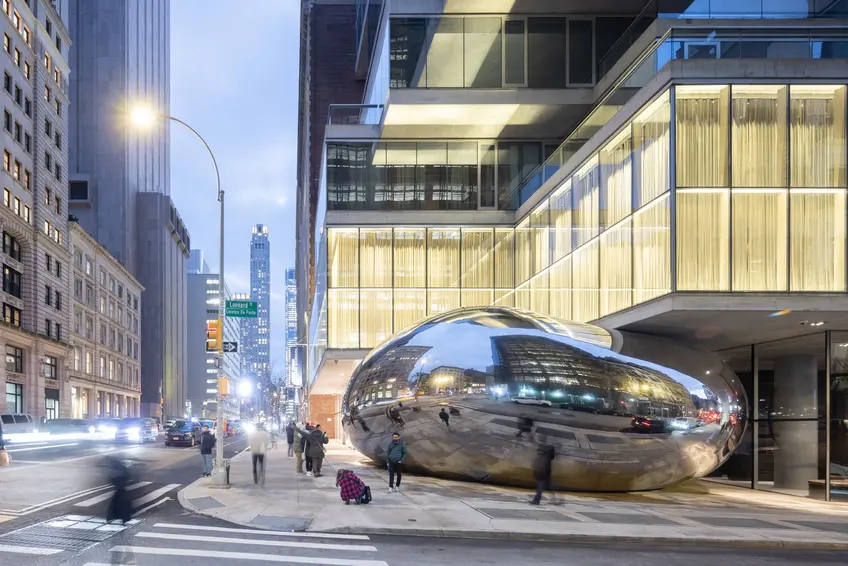 56 Leonard's Anish Kapoor sculpture. Photo credit: Iwan Baan
56 Leonard's Anish Kapoor sculpture. Photo credit: Iwan Baan
New York City is home to many of the world's most prestigious museums and art galleries, but certain residential buildings offer the best of the art world in-house. When the West 67th Street Artists Colony was established in the early 1900s, works by the buildings' residents were on display in the common areas and remain admired as artistic treasures. Decades later in the 1980s, as part of the Museum of Modern Art (MoMA) redesign, Museum Tower presented an art collection that includes works by Picasso and Caro, not to mention views of the MoMA’s sculpture garden. The trend continues today as developers and architects collaborate with artists from all over the world to convey a sense of luxury and creative thinking to woo potential buyers and invigorate the public realm.
Like real estate, the art market has softened this past year, moving from a seller’s market to a buyer’s market as economic headwinds have arisen from high interest rates, ongoing international conflicts, and a downturn in China's property market. There has been some noteworthy news in recent months, however. The New York Times reported last month, that a painting by Pablo Picasso of his young mistress was sold at Sotheby’s in New York for $139.4 million. Additionally, in early November, Christie’s closed out its Fall Marquee Week of 20th and 21st Century Art Sales, realizing a total of $864 million across five live auctions where over 96% of items were sold by value.
In this article:
As the art market finds its footing in the near term, high-end art pieces have continued to be more accessible to the public by way of luxury real estate. The architect Morris Adjmi, who looks to art more than architecture for inspiration says, “Art is becoming more important and more a part of all of our lives. You don’t only have to like what’s expensive. It is accessible, it enhances all of our lives. You buy what you like but it’s the history of art and how it influences our culture that makes it important.”
In this vein, more developers are understanding the allure of art, putting items on display in public and common amenity areas of the building for residents and visitors to enjoy. Now, you can live in a building with a Yayoi Kusama custom sculpture or a New York 1960s iconic photograph without buying a single piece of artwork.
From the first renderings, the “Jenga Tower” made an immediate impression on the Lower Manhattan skyline. These renderings also depicted a mirrored bean sculpture by Anish Kapoor at the base of the building, but construction difficulties and the pandemic delayed installation for years after the building welcomed its first residents. However, in February 2023, it was permanently installed in front of the building. The sculpture, which represents Mr. Kapoor’s first permanent public work in New York City, is highly reminiscent of a sculpture in Chicago’s Millennium Park.
“The relationship between building and sculpture is so closely cultivated that they appear to form a single unified object, exemplifying true synergy between art and architecture” – 56 Leonard website
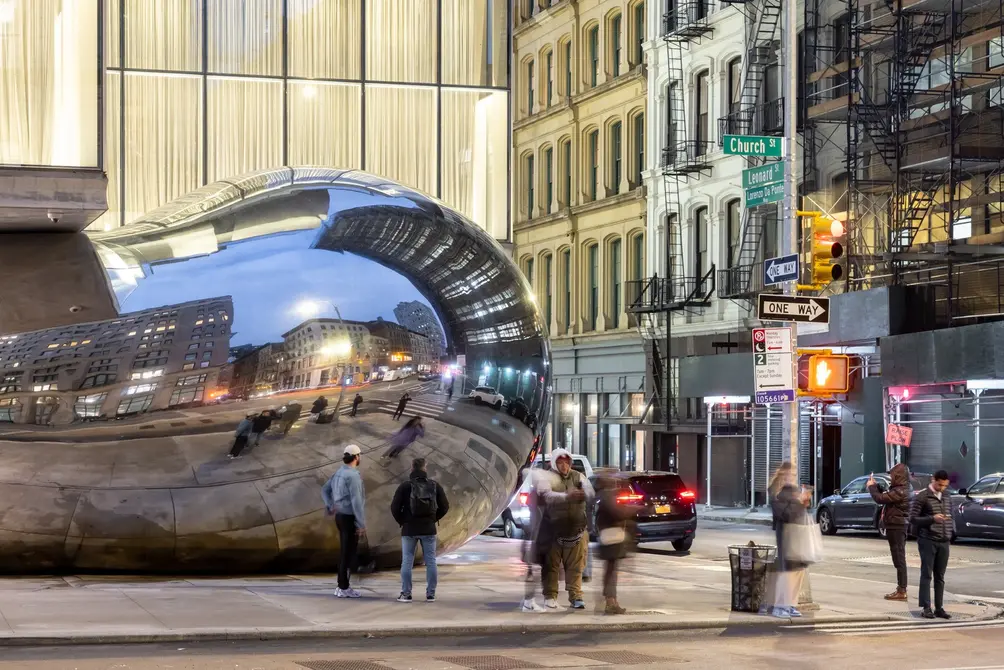 Photo credit: Iwan Baan
Photo credit: Iwan Baan
The Cortland took shape in a section of Chelsea best known for its gallery scene, and that mindset seems to have been applied to its interiors: The centerpiece of the lobby is “Stratus” by Markus Haase, a bronze and onyx light sculpture that is part of the artist's Cloud Series. Before it was installed in this residential building, it was on display at Design Miami Basel as part of Art Basel 2021.
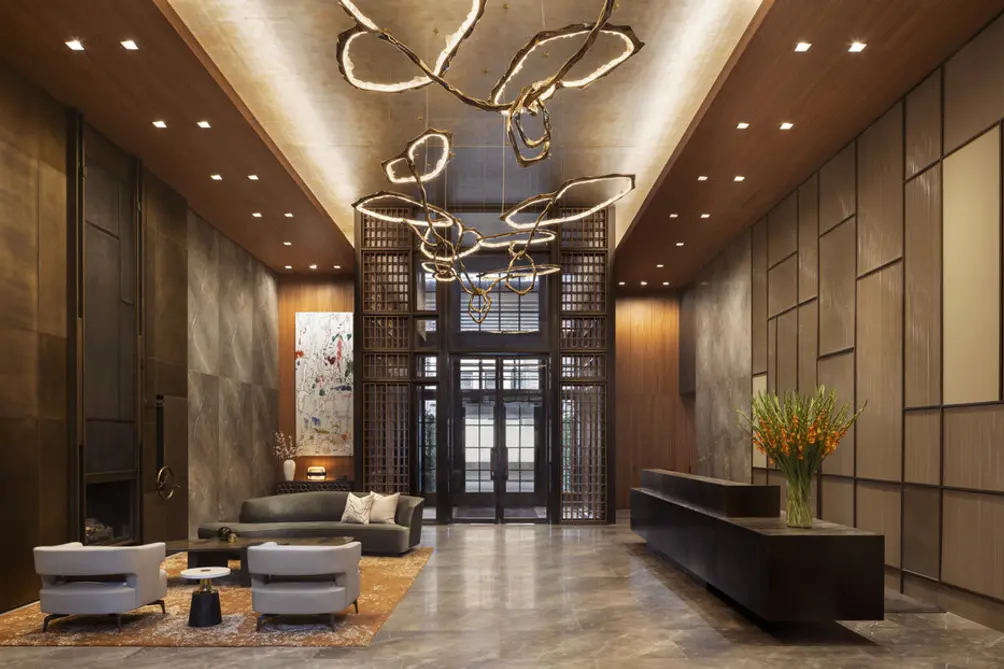 The Cortland's lobby. Credit: Collin Miller for Related Companies
The Cortland's lobby. Credit: Collin Miller for Related Companies
Vessel is the most famous piece of art in the Hudson Yards mega-development, and visitors from all over the world may access the ground-level base. However, only residents of 35 Hudson Yards enjoy access to a custom tapestry by Helena Hermarck, who has been described by Architectural Digest as “one of the last great tapestry artists working today.” The richly colored tapestry fills the wall and stretches to the ceiling.
When the Waldorf-Astoria was under construction in the late 1920s, the hotel announced a competition for the art above the entrance. Of the 400 entries submitted, they chose “Spirit of Achievement” by Nina Sæmundsson, the first Icelandic woman to make a living as a professional sculptor. It has been perched over the entrance since 1931; nearly 100 years later, the building is under construction and the statue has been relocated to the residential gallery for safekeeping. “Spirit of Achievement” is back in the news after an incredibly accurate replica was created with the help of 3D scanning technology and revealed near Ms. Sæmundsson’s Icelandic birthplace.
When the celebrated hotel opens to guests and residents alike (estimated for late 2024), “Spirit of Achievement” will be back in New York to greet them at the entrance. Inside, curator Simon de Pury is commissioning artists all over the world to create custom works for amenity spaces and common areas.
In New York, developer Harry Macklowe is as well known for his appreciation for art as his residential portfolio. The two were combined to great effect at One Wall Street. As the onetime office was converted to residential use, the Red Room was restored to its original glory and will figure prominently in the first American outpost of French department store Printemps. In the residential component, a custom tapestry in the lobby was designed in collaboration with a collective of artisan weavers in Mexico, and draws inspiration from Parisian artist Sonia Delaunay.
In sourcing a piece for the lobby, the team at 393 West End Avenue sought something “both timeless and contemporary” for the beautifully restored prewar building with modern characteristics, finishes, and amenities. To that end, residents arrive to mental winds, a modern painting by Esther Kläs. The symmetry and saturated colors of the painting beautifully play off the Art Deco-inspired lobby.
The elegant RAMSA-designed 20 East End Avenue also has art scattered around the building for its residents and their guests. Although developer Edward Baquero, President of Corigin Real Estate Group, admits, “Designing art for common elements is very difficult because you can’t make everybody happy,” it seems that he did just that.
In the “sexy, midnight blue lacquered library,” Baquero commissioned his architect, Robert A.M. Stern, to curate a New York-centric book collection ranging from books by Tom Wolfe and to books on New York graffiti.
Above the common library fireplace, hangs a gorgeous Jeffrey Millstein aerial photograph. Baquero jokes he shows potential residents the photo on his tour and says only true “New Yorkers” can live in this building so if they cannot identify that building, they cannot buy in his building.
In the gallery space outside of the library and billiards room, Baquero has created a salon-style collection with candid New Yorker photographs, like an image of Mia Farrow and Frank Sinatra leaving a ball at the Plaza and another of Basquiat and Warhol coming out of an area club in the 1960s.
As he was being interviewed, Baquero was receiving hundreds of images from his art curator, Elizabeth Fiore, as she scoured the Armory Show for two perfect pieces. “I’m looking for some contemporary art to pop these two 3’x4’ spaces a little. I want a bit of color for these two of the niches that are very central to the Lobby, on either side of the Oculus.”
As he was being interviewed, Baquero was receiving hundreds of images from his art curator, Elizabeth Fiore, as she scoured the Armory Show for two perfect pieces. “I’m looking for some contemporary art to pop these two 3’x4’ spaces a little. I want a bit of color for these two of the niches that are very central to the Lobby, on either side of the Oculus.”
Would you like to tour any of these properties?
Just complete the info below.
Or call us at (212) 755-5544
Located in Tribeca, 30 Park Place is a 926-foot-tall condominium tower with panoramic views of Midtown Manhattan, the Hudson and East Rivers, the New York Harbor and Statue of Liberty. Another building by architect Robert A.M. Stern, 30 Park Place was developed by Silverstein Properties and has 157 residences in a mix of one- to six-bedrooms.
The “Steam Portraits” sculpture in the building's public plaza is made up two undulating glass fountains by American glass artist, Martin Blank. Silverstein tasked Blank with creating them more than 15 years ago where Blank then sketched a variety of ideas for Mr. Silverstein to approve. Based on water in a constant sense of motion between the elusive effects of steam and wind against it, Blank chose clear, see-through glass to focus on this relationship.
NYC Rental Buildings with Public Art on Display
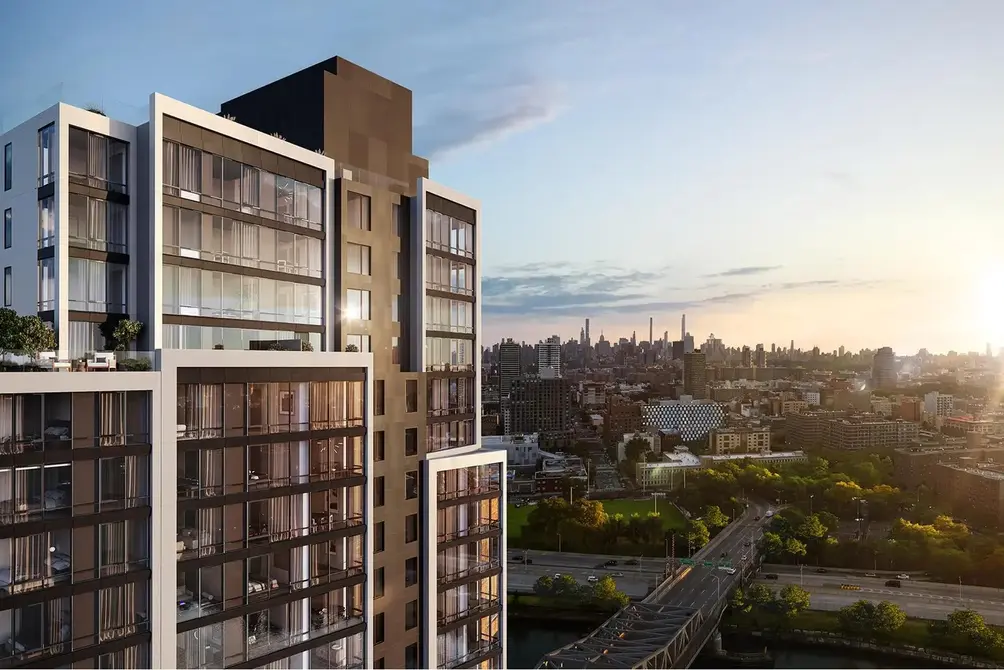 (Douglas Elliman)
(Douglas Elliman)
Leading real estate developer RXR transformed the lobby of its new residential project, Maven, into an immersive art experience. Featuring 10 large-scale wall-to-wall and floor-to-ceiling curated works from three local Bronx artists and six internationally renowned artists, the lobby artwork ranges from 8 to 19 feet in varying styles from pop to contemporary to graffiti. Maven, located at 2413 Third Avenue, is RXR’s first development in the Bronx featuring 200 elevated residences.
Most notably, the lobby features work from Mr.Brainwash, an enigmatic contemporary artist who emerged on the art scene in the early 2000s, captivating audiences worldwide with his unique vision. RXR also tapped internationally renowned artists WRDSMITH, Bollee Patino, Fat Cap Sprays, Plastic Jesus and Jimmy Paintz. Local NYC-based graffiti artists Cope 2, CRASH and PhoebeNewYork are also among the featured.
The Brodsky Organization and Greenland USA’s Brooklyn Crossing development — a new 51-story, 858-unit residential building and part of the Prospect Heights master planned development — features artwork from eight artists throughout varying common spaces within the building, all of whom are BIPOC and either live or work in Brooklyn including Alteronce Gumby and DJ Spooky.
The goal was to invest in works from local and diverse artists, putting money back into the pockets of small galleries and artists from the neighborhood. Overall, the works displayed differ from current European art typically seen in the community at public venues like the Barclays Center and reflect the Black and Brown roots of the people who originally lived in the area. The Brodsky Organization worked with The Art Committee, a small woman-owned business by industry veterans Molly Rand and Pilar Vahey, to help identify the artists and artwork featured throughout.
Residents of The Max, a TF Cornerstone-developed apartment complex in Hell’s Kitchen with over 1,000 luxury apartments, enjoy an expansive work of art that adorns the building’s courtyard. The 28,000-square-foot mural is the equivalent of an 11-story New York building and roughly one-third of a New York City block in length.
TF Cornerstone collaborated with Karlsson Wilker to create a mural that delves into the rich history of the Hell’s Kitchen neighborhood. A team of painters from ArtFXMurals, specializing in large, exterior high-rise work—the same team responsible for continuously painting the large vertical wall at Eighth Avenue and 34th Street by Penn Station—used approximately 1,800 pounds of paint for the mural, making it one of the largest in NYC.
TF Cornerstone collaborated with Karlsson Wilker to create a mural that delves into the rich history of the Hell’s Kitchen neighborhood. A team of painters from ArtFXMurals, specializing in large, exterior high-rise work—the same team responsible for continuously painting the large vertical wall at Eighth Avenue and 34th Street by Penn Station—used approximately 1,800 pounds of paint for the mural, making it one of the largest in NYC.
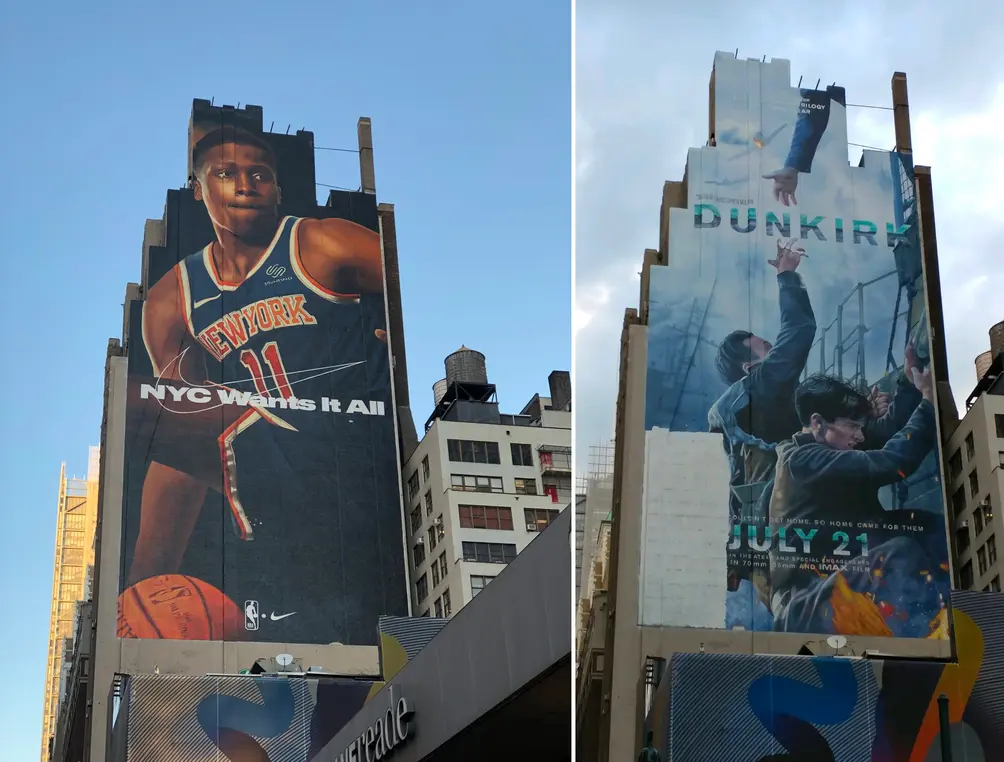 ArtFXMurals is routinely commissioned for advertising murals on the side of this Garment District building on Eighth Avenuenear 34th Street. (ArtFXMurals)
ArtFXMurals is routinely commissioned for advertising murals on the side of this Garment District building on Eighth Avenuenear 34th Street. (ArtFXMurals)
Jody Britt, who curated an entire building at 60 Fulton Street, called Exhibit, with New York-centric photography from the 1960s, 70s, and 80s, explains, “30-40 years ago, the adage in real estate was location, location, location. On the island of Manhattan and in Brooklyn, there isn’t anywhere that isn’t a prime location anymore. Everywhere is the location. So what will set a building apart from being already in the prime location when everything looks beautiful and sleek and wonderful? That’s what we focused on.”
“We created a love letter to New York City,” said Britt.
Scott L. Aaron, the Principal of Socius Development Group, and Britt began culling through thousands of images from Britt’s archive. “I wanted to show photos that hadn’t been seen, that were previously unreleased or not yet curated in a way that told a story. We wanted to pay homage to what made New York what is today – the time when the city was a little gritty, hungry, fascinating, and scary to some people because it didn’t care what people thought about it.”
All 23 floors of the building have a rotating selection of photographs (they will move up a floor each every few months), as well as the gym, amenity space on the 23rd floor, residents' penthouse club, lounges, parlor room, and dining area.
“We created a love letter to New York City,” said Britt.
Scott L. Aaron, the Principal of Socius Development Group, and Britt began culling through thousands of images from Britt’s archive. “I wanted to show photos that hadn’t been seen, that were previously unreleased or not yet curated in a way that told a story. We wanted to pay homage to what made New York what is today – the time when the city was a little gritty, hungry, fascinating, and scary to some people because it didn’t care what people thought about it.”
All 23 floors of the building have a rotating selection of photographs (they will move up a floor each every few months), as well as the gym, amenity space on the 23rd floor, residents' penthouse club, lounges, parlor room, and dining area.
In the gym, an entire wall is covered with a never before seen photo session contact sheet of Muhammad Ali taken by photographer Alan Tannenbaum. Aaron commented, “There are a lot of new buildings in Manhattan. This adds to our building’s identity. When people come to look at apartments, you want to be the one that stands out. You don’t want to look like everybody else. Once people get into the building and they see these great amenity spaces and their friends come over and walk through the corridors and see these pieces of art, it makes everyone feel good to have thoughtful design. It helps keep and attract residents.”
Sky is a 71-story rental residential building in Midtown West. Not only does the building’s infinity-loop motor court feature a custom Yayoi Kusama-carved bronze pumpkin (one of the most Instagrammed pieces of art in NYC) but there is an artisan-made chandelier in the lobby and more art scattered throughout the building, i.e. two of Kusama’s “Infinity Net” paintings, a fiberglass Kusama pumpkin positioned on the wall at the building’s fitness entrance, and extravagant paintings, “Lead Paintings” by Gunther Forg, ”Sunset at Palm Marina” by Nezih Cavusoglu and “Irregular Curves” by Sol LeWitt.
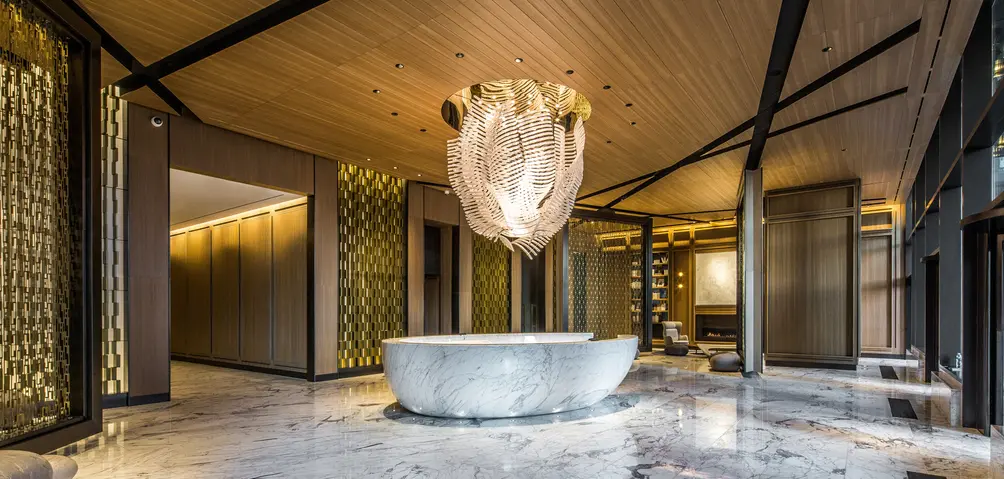 Lobby (Moinian Group)
Lobby (Moinian Group)
“Our goal was for residents of Sky to feel the immediate embrace of extraordinary artwork the moment they stepped into the building.”
And even more impressive is when the building opened, there was a 10,000-square-foot temporary exhibition space called SkyArt.
“We at The Moinian Group felt it was important to offer our residents at Sky a complete art experience. Our goal was for residents of Sky to feel the immediate embrace of extraordinary artwork the moment they stepped into the building. By fusing the sophistication of Sky’s Rockwell Group-designed interiors with imaginative art pieces from award-winning artists, such as Yayoi Kusama, we ultimately created a space that art lovers could appreciate. Our residents are attracted to great artwork and, by incorporating that into our building, we brought an exclusive offering that set Sky apart from the other residences in the marketplace.”
300 Ashland, developed by Two Trees, is located in Brooklyn’s Cultural District – Downtown Brooklyn. Residents live next door to renowned cultural institutions like BAM, BRIC, Mark Morris Dance, and Theater for a New Audience, and alongside arts organizations like Brooklyn Ballet, Issue Project Room, Roulette, and a suite of theatre companies and art galleries. And, in the coming years, BAM Cinema, MoCADA, 651 Arts, and the Brooklyn Public Library will open locations within the building.
Two Trees specifically focuses on emerging artists to capitalize on the creative energy of Brooklyn. This past spring, a temporary interactive public art installation transformed 300 Ashland's plaza into a colorful oasis of shimmering lights. Called “COMMON GROUND,” the public display was created by artist Cheryl Wing-Zi Wong with lighting design by Arup. It was brought to life by the Downtown Brooklyn Partnership and Van Alen Institute and featured colorful seating, sound-responsive lighting, and floor motifs that provide a vibrant space for people to gather. While this installation was dismantled in May, the plaza is home to rotating exhibits annually.
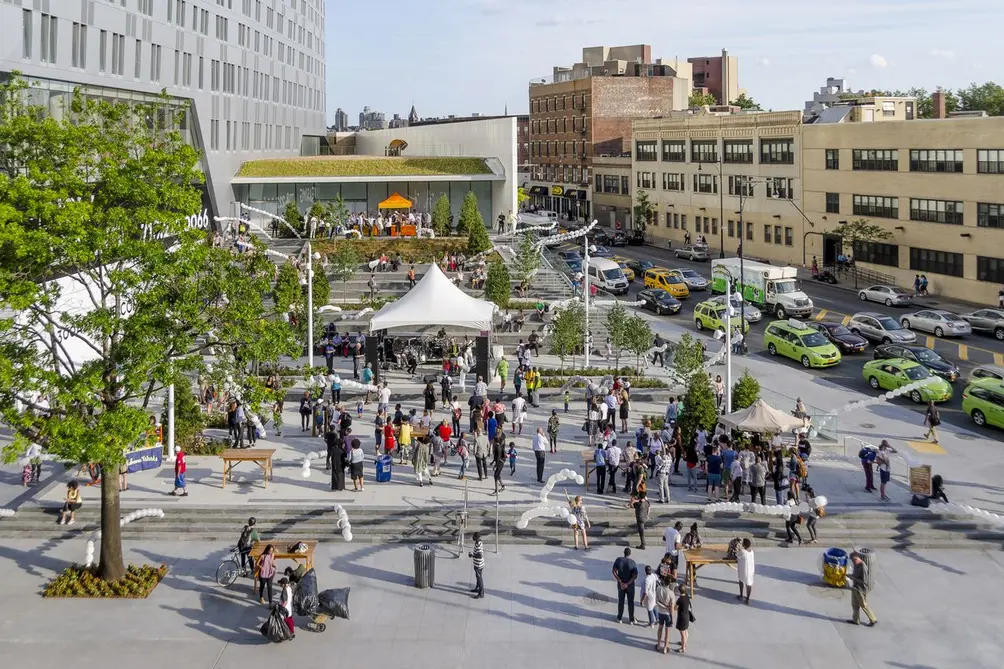 The public plaza at 300 Ashland in Downtown Brooklyn
The public plaza at 300 Ashland in Downtown Brooklyn
Kate Gavriel, Cultural Affairs Director at 300 Ashland says, “TwoTrees believes that the thriving arts community makes Brooklyn a special place to live, and residents of 300 Ashland only have to walk out their front door to have access to the best of what Brooklyn has offer.”
In terms of the residents’ response to the art, Rebecca Epstein, Director of Residential Leasing at 300 Ashland explained, “Every neighborhood is different as the demographic is drawn there for a specific reason. 300 Ashland residents are drawn to the cultural spaces and anticipate the role they will play in the neighborhood and the direct access to it. Dumbo residents love the access to galleries and the overall creative landscape of the neighborhood. And at 325 Kent, while we don’t have a strong connection to the arts (yet), the design, the lobby, the amenities, and the projected incorporation of the park and historical artifacts all play a significant part in why people choose to live in this building. We try not to lose sight of the connection to history and the ever-changing landscape here.”
Would you like to tour any of these properties?
Just complete the info below.
Or call us at (212) 755-5544
Would you like to tour any of these properties?


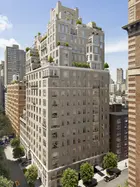
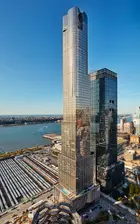
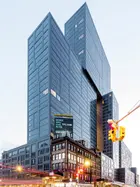

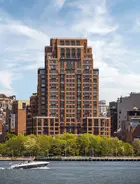
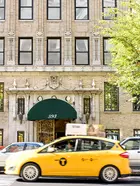
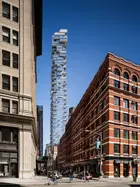
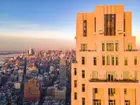
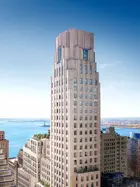
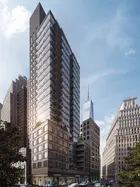
 6sqft delivers the latest on real estate, architecture, and design, straight from New York City.
6sqft delivers the latest on real estate, architecture, and design, straight from New York City.
